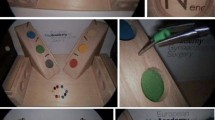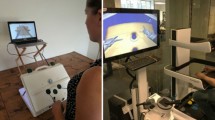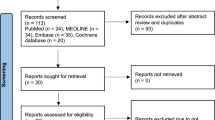Abstract
Purpose
To investigate the learning curve in four basic surgical skills in laparoscopic and robotic surgeries, and evaluate the approximate time needed to reach sufficient expertise in performing these tasks with the avatera® system.
Methods
Twenty urology residents with no previous experience in dry-lab and robotic surgery were asked to complete four basic laparoscopic tasks (peg transfer, circle cutting, needle guidance, and suturing) laparoscopically and robotically. All participants were asked to complete the tasks first after watching the Uroweb educational material and, second, after undertaking a 2-hour training in robotic and laparoscopic dry-lab. Thereafter, all trainees continued to undertake 2-hour training programs until being able to complete the tasks with the avatera® robot at the desired time. Paired t test and one-way ANOVA test were used to analyze time differences between the groups.
Results
Time needed to complete all tasks either robotically or laparoscopically was significantly less in the second compared to the first attempt for all Groups in each Task. In the robotic dry-lab, time needed to complete the tasks was significantly less than in the laparoscopic dry-lab. A significant effect of previous laparoscopic experience of the participants on the training time needed to achieve most of the goal times was detected.
Conclusion
The results of the study highlight the role of previous laparoscopic experience in the training time needed to achieve the performance time goals and demonstrate that the learning curve of basic surgical skills using the avatera® system is steeper than the laparoscopic one.

Similar content being viewed by others
Data availability
Data is available on request from the corresponding author.
References
Zahid A, Ayyan M, Farooq M, Cheema HA, Shahid A, Naeem F, Ilyas MA, Sohail S (2023) Robotic surgery in comparison to the open and laparoscopic approaches in the field of urology: a systematic review. J Robot Surg 17(1):11–29. https://doi.org/10.1007/s11701-022-01416-7
Surgical I (2020) Sustainability report 2020. https://www.intuitive.com/en-us/-/media/Project/Intuitive-surgical/files/pdf/2020-intuitive-sustainability-report.pdf
Dai X, Fan S, Hao H, Yang K, Shen C, Xiong G, Li X, Cui L, Li X, Zhou L (2021) Comparison of KD-SR-01 robotic partial nephrectomy and 3D-laparoscopic partial nephrectomy from an operative and ergonomic perspective: a prospective randomized controlled study in porcine models. Int J Med Robot 17(2):e2187. https://doi.org/10.1002/rcs.2187
Berguer R, Smith W (2006) An ergonomic comparison of robotic and laparoscopic technique: the influence of surgeon experience and task complexity. J Surg Res 134(1):87–92. https://doi.org/10.1016/j.jss.2005.10.003
Khosla A, Wagner AA (2016) Robotic surgery of the kidney, bladder, and prostate. Surg Clin N Am 96(3):615–636. https://doi.org/10.1016/j.suc.2016.02.015
Rassweiler JJ, Autorino R, Klein J, Mottrie A, Goezen AS, Stolzenburg JU, Rha KH, Schurr M, Kaouk J, Patel V, Dasgupta P, Liatsikos E (2017) Future of robotic surgery in urology. BJU Int 120(6):822–841. https://doi.org/10.1111/bju.13851
Avateramedical (2022) Avaterasystem. https://www.avatera.eu/en/avatera-system
Kallidonis P, Tatanis V, Peteinaris A, Katsakiori P, Gkeka K, Faitatziadis S, Vagionis A, Vrettos T, Stolzenburg JU, Liatsikos E (2023) Robot-assisted pyeloplasty for ureteropelvic junction obstruction: initial experience with the novel avatera system. World J Urol 41(11):3155–3160. https://doi.org/10.1007/s00345-023-04586-7
Peteinaris A, Kallidonis P, Tsaturyan A, Pagonis K, Faitatziadis S, Gkeka K, Vagionis A, Natsos A, Obaidat M, Anaplioti E, Tatanis V, Vrettos T, Liatsikos E (2023) The feasibility of robot-assisted radical cystectomy: an experimental study. World J Urol 41(2):477–482. https://doi.org/10.1007/s00345-022-04266-y
Gkeka K, Tsaturyan A, Faitatziadis S, Peteinaris A, Anaplioti E, Pagonis K, Vagionis A, Tatanis V, Vrettos T, Kallidonis P, Liatsikos E (2023) Robot-assisted radical nephrectomy using the novel avatera robotic surgical system: a feasibility study in a porcine model. J Endourol 37(3):273–278. https://doi.org/10.1089/end.2022.0596
Wong SW, Crowe P (2022) Factors affecting the learning curve in robotic colorectal surgery. J Robot Surg. https://doi.org/10.1007/s11701-022-01373-1
https://www.auanet.org/meetings-and-education/educational-programs/e-learning
Somani BK, Van Cleynenbreugel B, Gozen AS, Skolarikos A, Wagner C, Beatty J, Barmoshe S, Gaya Sopena JM, Kalogeropoulos T, Faba OR, Salas RS, Schmidt M, Siena G, Pini G, Palou J, Geraghty R, Veneziano D (2020) Outcomes of European Basic Laparoscopic Urological Skills (EBLUS) Examinations: Results from European School of Urology (ESU) and EAU Section of Uro-Technology (ESUT) over 6 Years (2013–2018). Eur Urol Focus 6(6):1190–1194. https://doi.org/10.1016/j.euf.2019.01.007
(EAU) EAoU (2022) Laparoscopy. https://uroweb.org/education-events/laparoscopy
Khan N, Abboudi H, Khan MS, Dasgupta P, Ahmed K (2014) Measuring the surgical “learning curve”: methods, variables and competency. BJU Int 113(3):504–508. https://doi.org/10.1111/bju.12197
Wiener S, Haddock P, Shichman S, Dorin R (2015) Construction of a urologic robotic surgery training curriculum: how many simulator sessions are required for residents to achieve proficiency? J Endourol 29(11):1289–1293. https://doi.org/10.1089/end.2015.0392
Schmidt MW, Koppinger KF, Fan C, Kowalewski KF, Schmidt LP, Vey J, Proctor T, Probst P, Bintintan VV, Muller-Stich BP, Nickel F (2021) Virtual reality simulation in robot-assisted surgery: meta-analysis of skill transfer and predictability of skill. BJS Open. https://doi.org/10.1093/bjsopen/zraa066
Lovegrove CE, Elhage O, Khan MS, Novara G, Mottrie A, Dasgupta P, Ahmed K (2017) Training modalities in robot-assisted urologic surgery: a systematic review. Eur Urol Focus 3(1):102–116. https://doi.org/10.1016/j.euf.2016.01.006
Brunckhorst O, Volpe A, van der Poel H, Mottrie A, Ahmed K (2016) Training, simulation, the learning curve, and how to reduce complications in urology. Eur Urol Focus 2(1):10–18. https://doi.org/10.1016/j.euf.2016.02.004
Soomro N, Hashimoto D, Porteous A, Ridley C, Marsh W, Ditto R, Roy S (2019) Systematic review of learning curves in robot-assisted surgery. BJS Open. https://doi.org/10.1002/bjs5.50235
Yurko YY, Scerbo MW, Prabhu AS, Acker CE, Stefanidis D (2010) Higher mental workload is associated with poorer laparoscopic performance as measured by the NASA-TLX tool. Simul Healthc 5(5):267–271. https://doi.org/10.1097/SIH.0b013e3181e3f329
Gauger P, Hauge L, Andreatta P, Hamstra S, Hillard M, Arble E, Kasten S, Mullan P, Cederna P, Minter R (2010) Laparoscopic simulation training with proficiency targets improves practice and performance of novice surgeons. Am J Surg 199:72–80. https://doi.org/10.1016/j.amjsurg.2009.07.034
Bric J, Connolly M, Kastenmeier A, Goldblatt M, Gould JC (2014) Proficiency training on a virtual reality robotic surgical skills curriculum. Surg Endosc 28(12):3343–3348. https://doi.org/10.1007/s00464-014-3624-5
McVey R, Goldenberg MG, Bernardini MQ, Yasufuku K, Quereshy FA, Finelli A, Pace KT, Lee JY (2016) Baseline laparoscopic skill may predict baseline robotic skill and early robotic surgery learning curve. J Endourol 30(5):588–592. https://doi.org/10.1089/end.2015.0774
Chahal B, Aydin A, Amin MSA, Ong K, Khan A, Khan MS, Ahmed K, Dasgupta P (2023) Transfer of open and laparoscopic skills to robotic surgery: a systematic review. J Robot Surg 17(4):1207–1225. https://doi.org/10.1007/s11701-022-01492-9
Kassite I, Bejan-Angoulvant T, Lardy H, Binet A (2019) A systematic review of the learning curve in robotic surgery: range and heterogeneity. Surg Endosc 33(2):353–365. https://doi.org/10.1007/s00464-018-6473-9
Brunaud L, Bresler L, Ayav A, Zarnegar R, Raphoz AL, Levan T, Weryha G, Boissel P (2008) Robotic-assisted adrenalectomy: what advantages compared to lateral transperitoneal laparoscopic adrenalectomy? Am J Surg 195(4):433–438. https://doi.org/10.1016/j.amjsurg.2007.04.016
Leite M, Carvalho AF, Costa P, Pereira R, Moreira A, Rodrigues N, Laureano S, Correia-Pinto J, Vilaca JL, Leao P (2016) Assessment of laparoscopic skills performance: 2D versus 3D vision and classic instrument versus new hand-held robotic device for laparoscopy. Surg Innov 23(1):52–61. https://doi.org/10.1177/1553350615585638
Moorthy K, Munz Y, Dosis A, Hernandez J, Martin S, Bello F, Rockall T, Darzi A (2004) Dexterity enhancement with robotic surgery. Surg Endosc 18(5):790–795. https://doi.org/10.1007/s00464-003-8922-2
Munz Y, Moorthy K, Dosis A, Hernandez JD, Bann S, Bello F, Martin S, Darzi A, Rockall T (2004) The benefits of stereoscopic vision in robotic-assisted performance on bench models. Surg Endosc 18(4):611–616. https://doi.org/10.1007/s00464-003-9017-9
Hopper AN, Jamison MH, Lewis WG (2007) Learning curves in surgical practice. Postgrad Med J 83(986):777–779. https://doi.org/10.1136/pgmj.2007.057190
Pierorazio PM, Patel HD, Feng T, Yohannan J, Hyams ES, Allaf ME (2011) Robotic-assisted versus traditional laparoscopic partial nephrectomy: comparison of outcomes and evaluation of learning curve. Urology 78(4):813–819. https://doi.org/10.1016/j.urology.2011.04.065
https://uroweb.org/eau-sections/eau-robotic-urology-section-erus
Herron DM, Marohn M (2008) A consensus document on robotic surgery. Surg Endosc 22(2):313–325. https://doi.org/10.1007/s00464-007-9727-5. (discussion 311–312)
Acknowledgements
The avatera system and all the disposable instruments were provided by avateramedical GmbH for the conduction of this experimental study.
Funding
No funds, grants, or other support was received.
Author information
Authors and Affiliations
Contributions
KG, AP, EA, SF, KP, TV carried out the experiments. AT, PK and VT conceived and planned the experiments. KP, AN, MO, AV, TS contributed to the interpretation of the results. KG, AP, PK took the lead in writing the manuscript. EL, PK supervised the project. All authors provided critical feedback and helped shape the research, analysis, and manuscript.
Corresponding author
Ethics declarations
Competing interests
Professor Liatsikos is medical advisor of Avateramedical. The other authors have nothing to declare.
Additional information
Publisher's Note
Springer Nature remains neutral with regard to jurisdictional claims in published maps and institutional affiliations.
Rights and permissions
Springer Nature or its licensor (e.g. a society or other partner) holds exclusive rights to this article under a publishing agreement with the author(s) or other rightsholder(s); author self-archiving of the accepted manuscript version of this article is solely governed by the terms of such publishing agreement and applicable law.
About this article
Cite this article
Anaplioti, E., Gkeka, K., Katsakiori, P. et al. How long do we need to reach sufficient expertise with the avatera® robotic system?. Int Urol Nephrol 56, 1577–1583 (2024). https://doi.org/10.1007/s11255-023-03914-5
Received:
Accepted:
Published:
Issue Date:
DOI: https://doi.org/10.1007/s11255-023-03914-5




